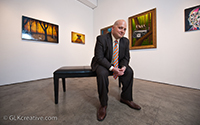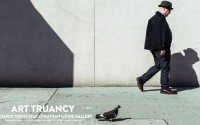Jenny Morgan, one of the artists in Stranger Than Fiction, our upcoming group exhibition (Sept 6—Oct 4, 2014) was recently interviewed for the cover story of Juxtapoz’s September 2014 issue. Here’s an excerpt:
—-
Adding something fresh and necessary to the genre of portraiture may seem impossible, but in that realm, Jenny Morgan is crushing it. Don’t label her paintings figurative or photoreal. Her extraordinary skills for rendering the human figure are beside the point. Layers of the unconscious are revealed in the reductive abstraction of her portraits. As she grinds away at physical and metaphorical surfaces to uncover a spirit, an honest representation of “the feels” becomes visible. Many can approximate likeness, but no one can expose the soft center of the human core quite like Jenny Morgan. — Kristin Farr
—-
How do you define the shadow self and what interests you about that concept?
The shadow self is the representation/manifestation of the rejected or denied aspects of our own personality. These aspects can be negative or positive characteristics, drives or belief systems that we do not accept as a part of who we are, so they are pushed down out of our awareness or even out of ourselves. I’m deeply fascinated by the idea that we are composed of a multitude of layers, most of which we have no conscious awareness.
My curiosity with the shadow self was piqued after listening to a lecture by Ken Wilber, one of my favorite contemporary philosophers. In his description of the shadow self, these rejected aspects can be so thoroughly shunned by our own conscious ego that the thought-forms and beliefs exit the realm of the mind and manifest in our exterior environment—and then start to look back at us. Our shadow reveals itself like a mirror in our daily lives through other people and relationships, or inanimate objects that stir emotional responses. For me, the allure of the shadow self lies in the conceptualization-turned-realization of thought manifesting into form. I no longer view the shadow self as a conceptual psycho-spiritual theory, but as a physical process. And this invisible, non-local process directly relates to the core of art making—the artist is taking thought and internal imagery and manifesting the invisible to the visible. I view this transformation of bringing the shadow elements to light as fundamental within portraiture, and I certainly embrace it with my own work as a basic principle. Being on the outside looking in, I am privy to a certain perspective of the sitter’s light and dark side.
How does your interest in the shadow self relate to your interest in the supernatural?
I think the spiritual element is the link. All of this seemingly invisible and mysterious activity resonates in a way that makes me feel connected to something outside of myself; whether you call it the Universe, God, nature, higher self or the great nothing, I am committed to understanding my relationship to it. I feel thankful that I am an artist and that I have a very tangible medium in which to discover and uncover my spirituality.
—-
Read the full interview with Jenny Morgan in the September 2014 issue of Juxtapoz Magazine.
See the slideshow of images that accompanied this online:
http://www.juxtapoz.com/current/in-the-magazine-jenny-morgan







